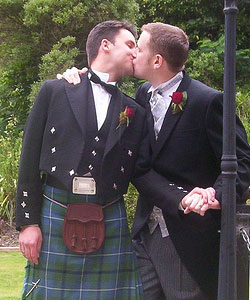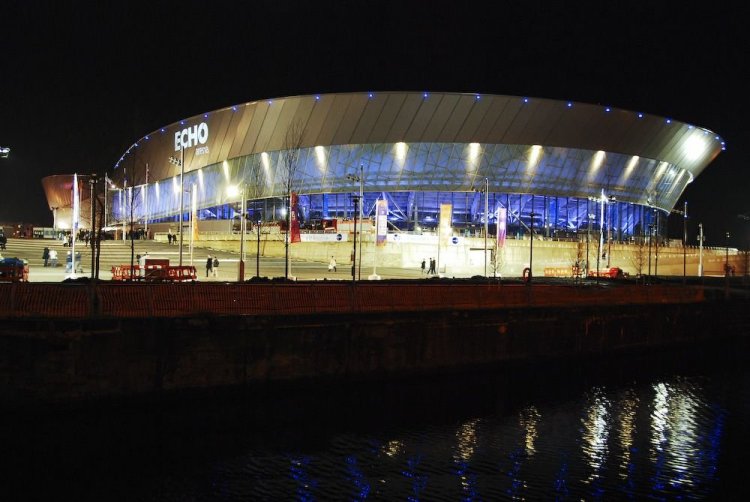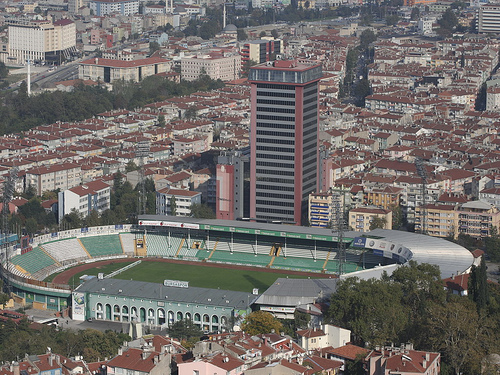profile no.5 - United Kingdom hosting city - LIVERPOOL
Liverpool is a city and metropolitan borough of Merseyside, England, along the eastern side of the Mersey Estuary. It was founded as a borough in 1207 and was granted city status in 1880. Liverpool is the fourth largest city in the United Kingdom (third largest in England) and has a population of 435,500, and lies at the centre of the wider Liverpool Urban Area, which has a population of 816,216.
Historically a part of Lancashire, the urbanisation and expansion of Liverpool were largely brought about by the city's status as a major port. By the 18th century, trade from the West Indies, Ireland and mainland Europe coupled with close links with the Atlantic Slave Trade furthered the economic expansion of Liverpool. By the early 19th century, 40% of the world's trade passed through Liverpool's docks, contributing to Liverpool's rise as a major city.
Inhabitants of Liverpool are referred to as Liverpudlians but are also known as "Scousers", in reference to the local dish known as "scouse", a form of stew. The word "Scouse" has also become synonymous with the Liverpool accent and dialect. Liverpool's status as a port city has contributed to its diverse population, which, historically, were drawn from a wide range of peoples, cultures, and religions, particularly those from Ireland. The city is also home to the oldest Black African community in the country and the oldest Chinese community in Europe.
The popularity of The Beatles and the other groups from the Merseybeat era contributes to Liverpool's status as a tourist destination; tourism forms a significant part of the city's modern economy. In 2007 the city celebrated its 800th anniversary, and in 2008 it held the European Capital of Culture title together with Stavanger, Norway.
In 2004, several areas throughout the city centre were granted World Heritage Site status by UNESCO. Referred to as the Liverpool Maritime Mercantile City, the site comprises six separate locations in the city including the Pier Head, Albert Dock and William Brown Street and includes many of the city's most famous landmarks.
HISTORY LIVERPOOL
King John's letters patent of 1207 announced the foundation of the borough of Liverpool, but by the middle of the 16th century the population was still only around 500. The original street plan of Liverpool is said to have been designed by King John near the same time it was granted a royal charter, making it a borough.
In the 17th century there was slow progress in trade and population growth. Battles for the town were waged during the English Civil War, including an eighteen-day siege in 1644. In 1699 Liverpool was made a parish by Act of Parliament, that same year its first slave ship, Liverpool Merchant, set sail for Africa. As trade from the West Indies surpassed that of Ireland and Europe, and as the River Dee silted up, Liverpool began to grow. The first commercial wet dock was built in Liverpool in 1715. Substantial profits from the slave trade helped the town to prosper and rapidly grow. By the close of the century Liverpool controlled over 41% of Europe's and 80% of Britain's slave commerce.
By the start of the 19th century, 40% of the world's trade was passing through Liverpool and the construction of major buildings reflected this wealth. In 1830, Liverpool and Manchester became the first cities to have an intercity rail link, through the Liverpool and Manchester Railway. The population continued to rise rapidly, especially during the 1840s when Irish migrants began arriving by the hundreds of thousands as a result of the Great Famine. By 1851, approximately 25% of the city's population was Irish-born. During the first part of the 20th century, Liverpool was drawing immigrants from across Europe.
The Housing Act 1919 resulted in mass council housing building across Liverpool during the 1920s and 1930s. Thousands of families were rehoused from the inner-city to new suburban housing estates, based on the pretext that this would improve their standard of living, though this is largely subjective. A large number of private homes were also built during this era. The process continued after the Second World War, with many more new housing estates being built in suburban areas, while some of the older inner city areas where also redeveloped for new homes.
During the Second World War there were 80 air-raids on Merseyside, killing 2,500 people and causing damage to almost half the homes in the metropolitan area. Significant rebuilding followed the war, including massive housing estates and the Seaforth Dock, the largest dock project in Britain. Much of the immediate reconstruction of the city centre has been deeply unpopular, and was as flawed as much town planning renewal in the 1950s and 1960s – the portions of the city's heritage that survived German bombing could not withstand the efforts of urban renewal. Since 1952 Liverpool has been twinned with Cologne, Germany, a city which also experienced aerial bombing during the war.
From the mid-1970s onwards Liverpool's docks and traditional manufacturing industries went into sharp decline. The advent of containerisation meant that the city's docks became largely obsolete. In the early 1980s unemployment rates in Liverpool were among the highest in the UK. In recent years, Liverpool's economy has recovered and has experienced growth rates higher than the national average since the mid-nineties.
GEOGRAPHY LIVERPOOL
Liverpool has been described as having "the most splendid setting of any English city." At 176 miles (283 km) northwest of London, the city of Liverpool is built across a ridge of sandstone hills rising up to a height of around 230 feet (70 metres) above sea-level at Everton Hill, which represents the southern boundary of the West Lancashire Coastal Plain. Liverpool Urban Area runs directly into Bootle, Crosby and Maghull in south Sefton to the north, and Kirkby, Huyton, Prescot and Halewood in Knowsley to the east. It faces Wallasey and Birkenhead across the River Mersey to the west.
Formby, to the north of the city, has an extensive dune system and forest which is home to many rare species including the Red Squirrel and Natterjack Toad.
Liverpool experiences a temperate maritime climate, like much of the British Isles, with relatively cool summers and mild winters.
TRANSPORT LIVERPOOL
Transport in Liverpool is primarily centred around the city's road and rail networks, both of which are extensive and provide links across the United Kingdom. Liverpool has an extensive local public transport network, which is managed by the Merseytravel, and includes buses, trains and ferries. Additionally, the city also has an international airport and a major port, both of which provides links to locations outside the country.
As a major city, Liverpool has direct road links with many other areas within England. To the east, the M62 motorway connects Liverpool with Hull and along the route provides links to several large cities, including Manchester, Leeds and Bradford. The M62 also provides a connection to both the M6 motorway and M1 Motorway, providing indirect links to more distant areas including Birmingham, Sheffield, Preston, London and Nottingham. To the west of the city, the Kingsway and Queensway Tunnels connect Liverpool with the Wirral Peninsula, providing links to both Birkenhead, and Wallasey. The A41 road, which begins in Birkenhead, also provides links to Cheshire and Shropshire and via the A55 road, North Wales. To the south, Liverpool is connected to Widnes and Warrington via the A562 road and subsequently across the River Mersey to Runcorn, via the Silver Jubilee Bridge. Plans have been developed in recent years to construct a second bridge, known as the Mersey Gateway, across the river in order to alleviate congestion on the route today.
Liverpool is served by two separate rail networks. The local rail network is managed and run by Merseyrail and provides links throughout Merseyside and beyond (see Local Travel below), while the national network, which is managed by Network Rail, provides Liverpool with connections to major towns and cities across the England. The city's primary mainline station is Lime Street station, which acts as a terminus for several lines into the city. Train services from Lime Street provide connections to numerous destinations, including London (in 2 hours 8 minutes with Pendolino tilting trains), Birmingham, Newcastle upon Tyne, Manchester, Preston, Leeds, Scarborough, Sheffield, Nottingham and Norwich. In the south of the city, Liverpool South Parkway provides a connection to the city's airport.
The Port of Liverpool is one of Britain's largest ports, providing passenger ferry services across the Irish Sea to Belfast, Dublin and the Isle of Man. Services are provided by several companies, including the Isle of Man Steam Packet Company, P&O and Norfolkline. In 2007, a new cruise liner terminal, the Princes' Dock, was opened in Liverpool, located alongside the Pier Head in the city centre. The terminal allows cruise ships to dock in the city (40 ships arrived during 2009) and also provide a base for trans-Atlantic services.
Liverpool John Lennon Airport, which is located in the south of the city, provides Liverpool with direct air connections across the United Kingdom and Europe. In 2008, the airport handled over 5.3 million passengers and today offers services to 68 destinations, including Berlin, Rome, Milan, Paris, Barcelona and Zurich.
Liverpool's local rail network is one of the busiest and most extensive in the country, covering 75 miles of track, with an average of 100,000 passenger journeys per weekday. Services are operated by the Merseyrail franchise and managed by the Merseyside Passenger Transport Executive. The network consists of three lines: the Northern Line, which runs to Southport, Ormskirk, Kirkby and Hunts Cross; the Wirral Line, which runs through the Mersey Railway Tunnel and has branches to New Brighton, West Kirby, Chester and Ellesmere Port; and the City Line, which begins at Lime Street, providing links to St Helens, Wigan, Preston, Warrington and Manchester. It should be noted that local services on the city line are operated by Northern Rail rather than Merseyrail, although the line itself remains part of the Merseyrail network. Within the city centre the majority of the network is underground, with five city centre stations and over 6.5 miles of tunnels.
The cross river ferry service in Liverpool, known as the Mersey Ferry, is managed and operated by Merseytravel, with services operating between the Pier Head in Liverpool and both Woodside in Birkenhead and Seacombe in Wallasey. Services operate at intervals ranging from 20 minutes at peak times, to every hour during the middle of the day and during weekends. Despite remaining an important transport link between the city and the Wirral Peninsula, the Mersey Ferry has become an increasingly popular tourist attraction within the city, with daytime River Explorer Cruises providing passengers with an historical overview of the River Mersey and surrounding areas.
CULTURE LIVERPOOL
As with other large cities, Liverpool is an important cultural centre within the United Kingdom, incorporating music, performing arts, museums and art galleries, literature and nightlife amongst others. In 2008, the cultural heritage of the city was celebrated with the city holding the title of European Capital of Culture, during which time a wide range of cultural celebrations took place in the city, including Go Superlambananas! and La Princesse.
Musicians from the city have produced 56 number one singles, more than any other city in the world. Both the most successful male band and girl group in global music history have contained Liverpudlian members. Liverpool is most famous as the birthplace of The Beatles and during the 1960s was at the forefront of the Beat Music movement, which would eventually lead to British Invasion. Many notable musicians of the time originated in the city including Billy J Kramer, Cilla Black, Gerry & the Pacemakers and The Searchers. The influence of musicians from Liverpool, coupled with other cultural exploits of the time, such as the Liverpool poets, prompted American poet Allen Ginsburg to proclaim that the city was "the centre of consciousness of the human universe". Other musicians from Liverpool have included Billy Fury, Echo and the Bunnymen, Frankie Goes to Hollywood, Frankie Vaughan and more recently The Zutons, Atomic Kitten and Heidi Range.
Liverpool has more galleries and national museums than any other city in the United Kingdom apart from London. National Museums Liverpool is the only English national collection based wholly outside London. The Tate Liverpool gallery houses the modern art collection of the Tate in the North of England and was, until the opening of Tate Modern, the largest e

bition space dedicated to modern art in the United Kingdom. The FACT centre hosts touring multimedia e

bitions, while the Walker Art Gallery houses an extensive collection of Pre-Raphaelites. Sudley House contains another major collection of pre 20th century art, and the number of galleries continues to expand: Ceri Hand Gallery opened in 2008, e

biting primarily contemporary art, and Liverpool University's Victoria Building was re-opened as a public art gallery and museum to display the University's artwork and historical collections which include the second-largest display of art by Audubon outside the US.
GAY LIVERPOOL - LIVERPOOL GAY QUARTER
Liverpool's Gay Quarter encompasses Stanley Street, Cumberland Street, Victoria St and Eberle St, and is where the bulk of the gay bars and clubs are located in Liverpool, in North West England. Stanley St is the main hub of the Gay Quarter and is where most of the bars are found.
VisitBritain, Britain's national tourism agency, acknowledges Liverpool as one of Britain's most notable gay cities, and recognises the growing investment in the Gay Quarter. Liverpool City Council hopes that further investment in the area, including partial pedestrianisation will further promote Liverpool as a gay destination.
Every year in November, the city hosts 'Homotopia', a two-week festival of gay culture including theatre, film, photography, and art. Launched in 2004, and supported by the Arts Council England, the celebration has now become a highlight of Liverpool's cultural calendar. The festival is directed by Gary Everett, an esteemed member of the local gay community, who has also been involved in the running of several of Liverpool's gay nightclubs. In contrast to a traditional 'Pride' festival, Homotopia is a forum to showcase GLBT talent in the field of arts, photography, performance etc., and is designed to bring together creative individuals irrespective of sexuality. Shows and events take place in theatres and galleries around Liverpool, and tend to be separate from the traditional gay scene. The opening and closing ceremonies do, however, often involve some form of club night.
Homotopia has been attended by numerous high profile figures from international gay society, including Peter Tatchell, Holly Johnson, Armistead Maupin, and Amy Lame. Homotopia also represents the gay community with its own float in Liverpool's annual Lord Mayor's Parade, along with other communities in the city.
'Our Story Liverpool', one of the projects associated with Homotopia, has also provided an opportunity to celebrate, record and archive the history and heritage of LGBT Liverpool, through the sharing of stories and experiences from members of the community. Before the project, much of the history had either been forgotten or ignored.
Liverpool also has its own LGBT Film Festival: 'Outsiders', directed by Matthew Fox, which brings the latest in gay film to the city. Since its inception in 2004, audience figures have grown considerably, and some experts say it is fast becoming one of the UK's leading gay film festivals, continuing to bring gay film premieres to Liverpool.
Liverpool also competes against other UK cities in the annual Mr Gay UK beauty competition, with the representative from the city participating in the national final. The winner of Mr Gay Europe 2007, Jackson Netto, was a student at Liverpool University, however, he represented Germany and not United Kingdom.
THE VENUE: ECHO ARENA LIVERPOOL
Echo Arena Liverpool is the arena half of ACC (Arena and Convention Centre) Liverpool located on the former King's Dock in Liverpool, England, United Kingdom. The BT Convention Centre forms the other half of the complex. Although the Echo Arena itself opened in January 2008, the ACC as a whole was officially opened by Her Majesty Queen Elizabeth II and Prince Philip during their visit to Liverpool on 22 May 2008.
The arena and convention centre complex is capable of hosting a whole range of events including music concerts, conventions, sporting events, children's entertainment and more. Since the arena's opening in 2008, it has regularly played host to many of the world's top musical acts. Many world famous artists including Oasis, Lady Gaga, Nickelback, Queen + Paul Rodgers, Rihanna and Beyoncé have performed at the Arena, with the latter on three separate occasions in the space of a year. As well as concerts, the arena has also hosted a number of major international events.
On 6 November 2008 the arena hosted the 2008 MTV Europe Music Awards, whilst on 14 December 2008 it was the venue for the BBC Sports Personality of the Year show.
Since its completion in 2008 the arena has become home to the Liverpool Summer Pops Festival, which takes place each year. The festival, which until previous years had operated from a huge big top tent, regularly attracts a number of well known popular artists.
The Echo Arena is set to hold host to the MOBO Awards on 20 October 2010, this will be only the second time that the awards have been held outside of London.
The arena has a capacity of 11000.
VOTE POLAND AND UNITED KINGDOM FOR FSC EURO CUP HOSTS








 the ball turns around, the water moves this heavy thing)
the ball turns around, the water moves this heavy thing)





















 (ok you don't have to do that)
(ok you don't have to do that)




















 bition space dedicated to modern art in the United Kingdom. The FACT centre hosts touring multimedia e
bition space dedicated to modern art in the United Kingdom. The FACT centre hosts touring multimedia e







































